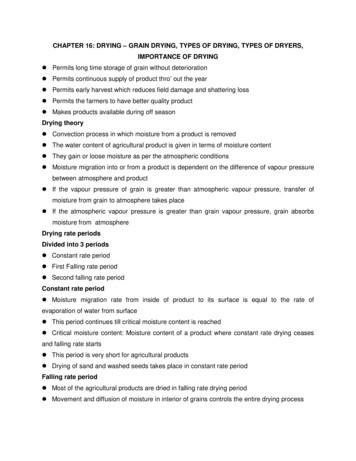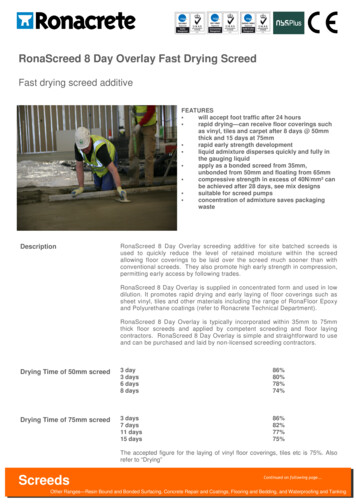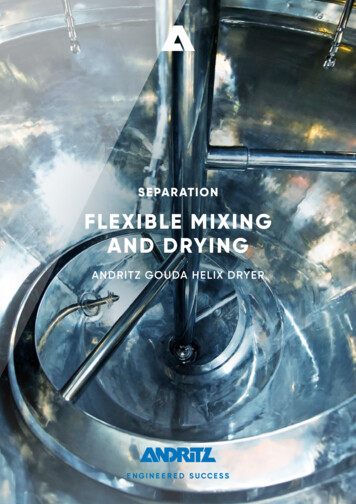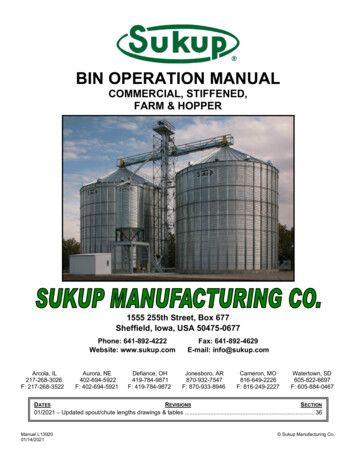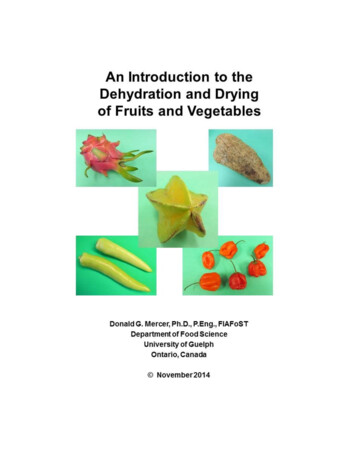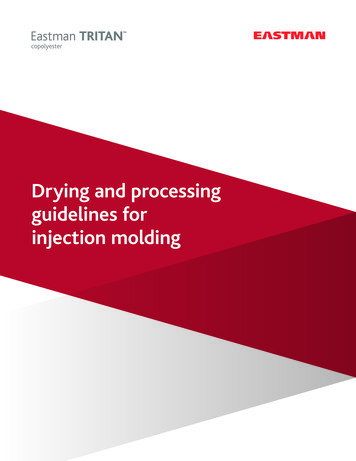
Transcription
Drying and processingguidelines forinjection molding
ContentsDrying and processing guidelines for injection molding . . . . . . . . . . . . . . 3Drying . . . . . . . . . . . . . . . . . . . . . . . . . . . . . . . . . . . . . . . . . . 3Processing . . . . . . . . . . . . . . . . . . . . . . . . . . . . . . . . . . . . . . . 4Barrel and melt temperatures . . . . . . . . . . . . . . . . . . . . . . . . . . 4Mold temperatures . . . . . . . . . . . . . . . . . . . . . . . . . . . . . . . . 5Fill/injection speed . . . . . . . . . . . . . . . . . . . . . . . . . . . . . . . . 5Screw speed (rpm) . . . . . . . . . . . . . . . . . . . . . . . . . . . . . . . . . 5Pack and hold pressure . . . . . . . . . . . . . . . . . . . . . . . . . . . . . . 5Cushion size . . . . . . . . . . . . . . . . . . . . . . . . . . . . . . . . . . . . 5Back pressure . . . . . . . . . . . . . . . . . . . . . . . . . . . . . . . . . . . 6Decompression (suck back) . . . . . . . . . . . . . . . . . . . . . . . . . . . . 6Other considerations . . . . . . . . . . . . . . . . . . . . . . . . . . . . . . . . 06Screw and barrel design . . . . . . . . . . . . . . . . . . . . . . . . . . . . . . 6Purging . . . . . . . . . . . . . . . . . . . . . . . . . . . . . . . . . . . . . . . 6Annealing . . . . . . . . . . . . . . . . . . . . . . . . . . . . . . . . . . . . . . 7Mold construction . . . . . . . . . . . . . . . . . . . . . . . . . . . . . . . . . . . 7General guidelines . . . . . . . . . . . . . . . . . . . . . . . . . . . . . . . . 07Cold runner/cold sprue guidelines . . . . . . . . . . . . . . . . . . . . . . . . 7Hot runner mold guidelines . . . . . . . . . . . . . . . . . . . . . . . . . . . 7
Drying and processing guidelinesfor injection moldingEastman Tritan copolyester provides customers excellenttoughness, as well as clarity, chemical resistance, dishwasherdurability, dimensional stability, low and stable shrinkagerates, and other enhanced physical properties. Versions ofTritan are also available with various additive packages, suchas mold release, UV, and color. To optimize these physicalproperties and widen the processing window, some dryingand processing guidelines are listed.DryingEffective drying of Eastman Tritan copolyester is key toshot-to-shot consistency and optimum part performance.The following are important points to consider for properdrying of Tritan copolyester. Dew point: Use a desiccant type or similar drying systemproviding dry air at a minimum dew point of –29 C (–20 F). Time and temperature: Dry Tritan for 4 hours minimum at88 C (190 F). If longer residence time in the dryers is required,such as overnight, lower set temperature to 82 C (180 F).Inlet air temperature needs to be controlled within 3 C( 37 F) throughout the drying cycle. Figure 1 shows theeffect of drying time on pellet moisture content. Airflow: The dryer should have sufficient airflow to assure auniform pellet temperature throughout the dryer. A minimumof 0.06 m3/min/kg airflow is suggested for each kilogram ofpolymer processed per hour (1.0 cfm per pound per hour ofpolymer processed). Moisture content: The goal of drying is to lower the moisturecontent of the polymer to 0.03% or lower as measured by theKarl Fisher method, or by weight loss methods calibrated forTritan. Weight loss methods involve a heating temperaturenear 160 C (320 F) for this polymer.Figure 1Effect of drying time on pellet moisture contentin Eastman Tritan copolyesterPellet moisture content (wt%)0.15Initial pellet moisture content0.43 wt%0.10.05Target maximum moisture content0024681012Drying time @ 88 C (190 F) (hr)Dehumidified air dryer, dew point – 29 C (– 20 F)3
Processing A flat temperature profile setting is normally used when shotsize is approximately 50% of barrel capacity; i.e., a barrel witha three-zone system might have settings as follows:Barrel and melt temperaturesConsistent part production requires attention to all phasesof the injection molding process. Processing conditions shouldbe optimized to ensure material integrity and maximum partperformance. Some recommendations follow for processingEastman Tritan copolyester. P rocessing at the optimal processing temperature andminimum residence time in the machine will assist inmaximizing physical properties.a W ell-dried material is key for shot-to-shot uniformity.Engineering materials, such as Tritan, can suffer degradationat their processing temperatures because of hydrolyticdegradation. N ormal processing temperatures are in the range of 282 C(540 F) plus or minus 5 –10 C (10 –20 F) measured by airshot. Parts run at faster cycle times utilizing higher barrelcapacity, 50%–80%, can be run at the higher end of the melttemperature range. Conversely, when parts are molded withlong cycle times utilizing a minor amount of barrel capacity,10%–25%, the processor should strive to run Tritan at thelower range of the proposed melt temperature.Rear zone282 C (540 F)aCenter zone282 C (540 F)aFront zone282 C (540 F)aNozzle zone282 C (540 F)Hot runners282 C (540 F)Actual melt temperature (purged on cycle)282 C (540 F)S ince each machine is different, the barrel set temperatures might need to be set as much as10 –20 C (20 –40 F) lower than the targeted melt temperature because of shear heating.It is good practice to determine actual melt temperature, temperature inside machinenozzles, and inside hot sprues and runners using a pyrometer. Also, it is important that thecasting around the throat of the injection molding machine is cooled to provide optimumpickup of material. I n special situations, Eastman Tritan copolyester does havea wider processing window, depending on the process, rangingfrom approximately 260 C (500 F) where flow and screwrecovery become stiff, up to approximately 304 C (580 F)where splay may begin at 10-minute melt residence times.A good setting is generally 282 C (540 F) while targeting amelt residence time (screw and hot runner time) of 5–6minutes. Figure 2 shows the effect of melt residence time onmaterial integrity over a range of melt temperatures.Figure 2IV loss (dL/g)Inherent viscosity (IV) loss in Eastman Tritan copolyester isa function of melt residence time over a melt temperature range.IV is a commonly used molecular weight indicator in copolyester.0Melt temperature–0.05282 C (540 F)–0.1299 C (570 F)–0.15–0.2313 C (595 F)–0.25–0.30246Melt residence time (min)4810
Mold temperaturesScrew speed (rpm)Good temperature uniformity through the mold and goodtemperature control to a set point are key. P lastication should be slowed to the minimum speednecessary to recover the screw during part cooling andsit at the rear position only 2 to 5 seconds before the moldopens. This minimizes high-speed shear and tends to makethe melt more uniform. In processing Eastman Tritan copolyester, lower rpm can make screw recovery moresteady and consistent. Actual mold surface temperatures ranging from 38 –66 C(100 –150 F) produce the best low-stress parts. Recall thatthe actual water temperature going into the mold may belower than mold surface temperature if heat transfer isrelatively slow. A morphous Eastman Tritan copolyester requires coldermolds than some other plastics, so preparing cooling aheadof time pays dividends in cycle time and processability.High mold temperatures, even in small areas of the mold,can cause sticking. Ample mold cooling channels, uniformwall thickness design, good cooling of pins and thin steelareas, good cooling near hot spots such as sprues or hotrunners, insulating areas around hot runners, good watersupply with few flow restrictions, and thermolators for exactsetting control of water temperature all assist in generatingfast-cycling parts with good surface appearance. W ith good cooling as previously outlined, the cooling portionof the cycle can be minimized to a point where the part issolidified and easily ejected while the larger diameter sprueis often still soft and rubbery. A dditional cooling could be needed to prevent sprue sticking.Review the mold construction guidelines on page 7 foradditional information.Fill/injection speed F ill speed used for Eastman Tritan copolyester is slowerthan typical plastics. Machines with fill speed profile capabilityare recommended. Where fill speed profiling is available,starting the fill at a very slow speed such as 13 mm (0.5 in.)per second for the first 5%–15% of the shot, then increasingto 43 mm (1.7 in.) per second, then slowing to 23 mm (0.9 in.)per second is often successful. The slower initial fill speedminimizes gate blush. Where direct sprue gating into thepart is used, a moderate to fast fill rate, such as 38–56 mm(1.5–2.2 in.) per second, is suggested.Pack and hold pressure W here direct sprue gating into the part is used, longer holdtimes in combination with lower hold pressures might benecessary. If a void develops at the base of the sprue, thesprue has a tendency to stick in the mold, separating at thepart. Packing out the void strengthens the sprue so that it willnow release with the part. Having long hold times of 8 to 12seconds and lower hold pressures of 34–52 MPa (5,000–7,500psi)1 will feed material to the sprue to fill the void while notoverpacking the sprue. Overall cycle time does not have to beextended if the cooling time is decreased by the same amountthe hold time is increased. Sticking can also occur with aconventional runner at the junction of the runner and suckerpin. Again, if the sprue sticks in the mold, utilizing the samemethodology will help solve the problem.Cushion size C ushion size should be at the absolute minimum to ensurethe screw does not hit bottom and the pack and hold pressuresare getting into the part. The cushion left at the end of thepack and hold are typically 5–10 mm (0.2–0.4 in.) dependingon machine size and injection speed. Larger cushions can addto holdup time in the barrel and aggravate degradation. If thescrew continues to move forward at the end of the shot whenadequate time is given to come to a stop, this is a sign of aleaking check valve. A leaking check valve may also cause shortshots and shot-to-shot variability.1 ote these pressures are actual melt pressures, not gauge pressures (often gauge readings areN1/10 actual pressures depending on machine and barrel). G ate geometry is also very important to part appearance nearthe gate. If the gate or runner has sharp corners or othernonstreamlined features in the flow channel, these may needto be radiused to reduce blush near the gate. Gate thickness aswell as speed can influence gate blush. Gate thicknesses lessthan 1.0 mm (0.045 in.) are not suggested for most gate types.5
Table 1Summary of drying and processing conditionsEastman Tritan copolyesterConditionTX1000 andTX1001TX2000 andTX2001 –29 ( –20) –29 ( –20)Drying conditionsDryer air dew point, C ( F)Drying time, hr4488 (190)88 (190)Dryer airflow, m /hr 3.7 3.7Moisture content, % 0.03 0.03Drying temperature, C ( F)3Processing temperaturesZones, C ( F) Rear Center FrontSet barrel temperatures to reachtarget melt temperature, up to10 –20 C (50 –68 F) below target,depending on shear heating.Nozzle, C ( F)282 (540)282 (540)Hot runners, C ( F)282 (540)282 (540)Melt temperature, C ( F)282 (540 )282 (540 )Mold temperature, C ( F)60 (140)66 (150)Machine conditionsFill/injection speedScrew speed, rpmPack and hold pressure, MPa (psi)Cushion size, mm (in.)Back pressure, MPaslowminimum34–52 (5,000-7,500)5–10 (0.2–0.4)10–15Back pressure B ack pressure is usually kept to a minimum of about10 MPa (1,500 psi).2 However, to improve melt uniformity(and mix concentrates), increase melt temperature, or toget rid of air entrapment (air splay), back pressure can beincreased gradually to as much as 15.5 MPa (2,250 psi).2High back pressures can aggravate drooling into the moldand require additional decompression.Decompression (suck back) I n general use, there is very little or no decompression.Decompression tends to pull air back into the nozzlecausing splay in the next shot. Very small amounts ofdecompression can be used to reduce drool if needed.Other considerationsScrew and barrel design E astman Tritan copolyester has been processed in awide variety of “general-purpose” screws with compressionratios in the 2.8:1 or 3:1 range and L/D ratios of 18–22:1.The transition zone should have a gradual transition(typically 4–6 diameters) so that the high shear heatingof a sudden transition is avoided. Screws should be chosento be compatible with the hardness of the barrel materialto minimize wear as with any plastic material. Unfilledmaterials, such as Tritan, are generally very mild on screwwear. Corrosion of barrel and screw parts is not expectedwith Tritan.PurgingPurging with other materials is not needed when EastmanTritan copolyester is going to be run again after a shutdown.For a machine shutdown, such as on a weekend, simply shutoff the pellet feed, run the screw empty, and turn off heatsto the barrels and hot runners. Start up again with barrel heatswhich take the longest, then turn on hot runners with justenough time to reach set point at the same time as barrels.When set points are reached, start right away to avoid sittingand cooking the polymer. For short shutdowns such asduring brief repairs, generally if the machine is sitting at settemperature longer than about 10 minutes, it’s suggested topurge (air shots) the barrel contents and restart molding.Purging from Eastman Tritan copolyester to other polymers: Purge with acrylics, polystyrene, commercial purgingcompounds, or the polymer to follow Tritan.26 ote these pressures are actual melt pressures not gauge pressures (often gauge readingsNare 1/10 actual pressures depending on machine and barrel).
Annealing When mold surface temperatures are maintained inthe suggested ranges, relief of residual stress throughannealing is unnecessary. This recommendation shouldbe evaluated in individual cases where residual stressis of particular concern.Mold constructionThe following guidelines are to minimize cold sprue stickingor sticking around the gate, reduce cycle time, and open theprocessing window.General guidelines Design molds to maintain the desired uniform mold surfacetemperature of 38 –66 C (100 –151 F) even when run ataggressive cycle times. Use water line spacing of 2–2.5x diameter of cooling linebetween center line. Use high heat transfer alloy sprue brushings such asPerformance Alloy Performance Sprue Bushings . Alloysprue bushings are fabricated from raw materials thatenjoy significantly better thermal efficiency thantraditional steel sprue bushings.Hot runner mold guidelines Cleanly separate the hot and cold areas of the mold withgood insulation systems so that melt is uniform at 282 C(540 F), and the well-cooled mold is maintained at itsuniform surface temperature of 38 –66 C (100 –150 F),especially including the area around the gate. Ideally, the melt should be maintained at the sametemperature generated at the discharge of the screw all theway through the machine nozzle, mold sprue, hot runnermanifold, and hot runner drops and tips. Valve gates are the preferred gating style for hot runnersystems with Tritan copolyesters. Air poppets should be offset from the center line of the sprueor gate as far as possible. Balanced runner systems are suggested so that temperaturesand pressures are similar for all cavities and flow issimultaneous to all cavities.Cold runner/cold sprue guidelines Taper to be 3 minimum (included angle) on the sprue bushing. Shorten the sprue bushing “L” dimension to less than 75 mm(3 in.) in length. Orifice size of the sprue bushing where the sprue bushingmeets the nozzle should be 4–7 mm (5/32–9/32 in.) diameter.Larger parts will need orifice diameters of 7 mm (9/32 in.)while smaller parts will need only 4 mm (5/32 in.).F or example, a sprue bushing for a medium-sized partshould have a length of 75 mm (3 in.) or less and a spruebushing orifice diameter of 5.5 mm (7/32 in.). The sprue bushing is to have a high polish in the sprue area. Increase cooling around the sprue bushing—suggest upper andlower water line circuits. Maintain good surface contact between the sprue bushing andmold surface.– Suggest line-on-line interference fit.– Surface contact is to be on the head of the sprue bushingas well as the shaft.7
Eastman Chemical CompanyFor more information, visit eastman.comfor data sheets, Safety Data Sheets,General Processing and Design Guidelines,or contact your Eastman representative at1-800-EASTMAN.Corporate HeadquartersP.O. Box 431Kingsport, TN 37662-5280 U.S.A.Telephone:U.S.A. and Canada, 800-EASTMAN (800-327-8626)Other Locations, (1) 423-229-2000Fax: (1) 423-229-1193Eastman Chemical Latin America9155 South Dadeland Blvd.Suite 1116Miami, FL 33156 U.S.A.Telephone: (1) 305-671-2800Fax: (1) 305-671-2805Eastman Chemical B.V.Fascinatio Boulevard 602-6142909 VA Capelle aan den IJsselThe NetherlandsTelephone: (31) 10 2402 111Fax: (31) 10 2402 100Eastman (Shanghai) ChemicalCommercial Company, Ltd. Jingan Branch1206, CITIC SquareNo. 1168 Nanjing Road (W)Shanghai 200041, P.R. ChinaTelephone: (86) 21 6120-8700Fax: (86) 21 5213-5255Eastman Chemical Japan Ltd.MetLife Aoyama Building 5F2-11-16 Minami AoyamaMinato-ku, Tokyo 107-0062 JapanTelephone: (81) 3-3475-9510Fax: (81) 3-3475-9515Eastman Chemical Asia Pacific Pte. Ltd.#05-04 Winsland House3 Killiney RoadSingapore 239519Telephone: (65) 6831-3100Fax: (65) 6732-4930www.eastman.comAlthough the information and recommendations set forth herein are presentedin good faith, Eastman Chemical Company makes no representations orwarranties as to the completeness or accuracy thereof. You must make yourown determination of their suitability and completeness for your own use,for the protection of the environment, and for the health and safety ofyour employees and purchasers of your products. Nothing contained hereinis to be construed as a recommendation to use any product, process, equipment,or formulation in conflict with any patent, and we make no representations orwarranties, express or implied, that the use thereof will not infringe any patent.NO REPRESENTATIONS OR WARRANTIES, EITHER EXPRESS OR IMPLIED, OFMERCHANTABILITY, FITNESS FOR A PARTICULAR PURPOSE, OR OF ANYOTHER NATURE ARE MADE HEREUNDER WITH RESPECT TO INFORMATIONOR THE PRODUCT TO WHICH INFORMATION REFERS AND NOTHING HEREINWAIVES ANY OF THE SELLER’S CONDITIONS OF SALE.Safety Data Sheets providing safety precautions that should be observed whenhandling and storing our products are available online or by request. Youshould obtain and review available material safety information before handlingour products. If any materials mentioned are not our products, appropriateindustrial hygiene and other safety precautions recommended by theirmanufacturers should be observed. 2013 Eastman Chemical Company. Eastman, The results of insight, and Tritanare trademarks of Eastman Chemical Company. Performance Sprue Bushings isa trademark of Performance Alloys and Services, Inc.TRS-DUR-244 11/13
of the injection molding process Processing conditions should be optimized to ensure material integrity and maximum part . where splay may begin at 10-minute melt residence times A good setting is generally 282 C (540 F) while targeting a melt residence time (screw and hot runner time) of 5-6 .
